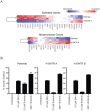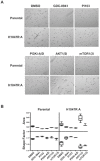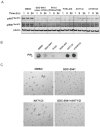Active PI3K pathway causes an invasive phenotype which can be reversed or promoted by blocking the pathway at divergent nodes
- PMID: 22570710
- PMCID: PMC3343052
- DOI: 10.1371/journal.pone.0036402
Active PI3K pathway causes an invasive phenotype which can be reversed or promoted by blocking the pathway at divergent nodes
Abstract
The PTEN/PI3K pathway is commonly mutated in cancer and therefore represents an attractive target for therapeutic intervention. To investigate the primary phenotypes mediated by increased pathway signaling in a clean, patient-relevant context, an activating PIK3CA mutation (H1047R) was knocked-in to an endogenous allele of the MCF10A non-tumorigenic human breast epithelial cell line. Introduction of an endogenously mutated PIK3CA allele resulted in a marked epithelial-mesenchymal transition (EMT) and invasive phenotype, compared to isogenic wild-type cells. The invasive phenotype was linked to enhanced PIP(3) production via a S6K-IRS positive feedback mechanism. Moreover, potent and selective inhibitors of PI3K were highly effective in reversing this phenotype, which is optimally revealed in 3-dimensional cell culture. In contrast, inhibition of Akt or mTOR exacerbated the invasive phenotype. Our results suggest that invasion is a core phenotype mediated by increased PTEN/PI3K pathway activity and that therapeutic agents targeting different nodes of the PI3K pathway may have dramatic differences in their ability to reverse or promote cancer metastasis.
Conflict of interest statement
Figures






Similar articles
-
Inhibition of PI3K Pathway Reduces Invasiveness and Epithelial-to-Mesenchymal Transition in Squamous Lung Cancer Cell Lines Harboring PIK3CA Gene Alterations.Mol Cancer Ther. 2015 Aug;14(8):1916-27. doi: 10.1158/1535-7163.MCT-14-0892. Epub 2015 May 26. Mol Cancer Ther. 2015. PMID: 26013318
-
Preclinical modeling of combined phosphatidylinositol-3-kinase inhibition with endocrine therapy for estrogen receptor-positive breast cancer.Breast Cancer Res. 2011 Mar 1;13(2):R21. doi: 10.1186/bcr2833. Breast Cancer Res. 2011. PMID: 21362200 Free PMC article.
-
Phosphoinositide 3-kinase (PI3K) pathway alterations are associated with histologic subtypes and are predictive of sensitivity to PI3K inhibitors in lung cancer preclinical models.Clin Cancer Res. 2012 Dec 15;18(24):6771-83. doi: 10.1158/1078-0432.CCR-12-2347. Epub 2012 Nov 7. Clin Cancer Res. 2012. PMID: 23136191
-
Combination of PI3K and MEK inhibitors yields durable remission in PDX models of PIK3CA-mutated metaplastic breast cancers.J Hematol Oncol. 2020 Feb 22;13(1):13. doi: 10.1186/s13045-020-0846-y. J Hematol Oncol. 2020. PMID: 32087759 Free PMC article.
-
PI3K pathway-directed therapeutic strategies in cancer.Curr Opin Investig Drugs. 2010 Jun;11(6):615-28. Curr Opin Investig Drugs. 2010. PMID: 20496256 Review.
Cited by
-
Everolimus restrains the paracrine pro-osteoclast activity of breast cancer cells.BMC Cancer. 2015 Oct 14;15:692. doi: 10.1186/s12885-015-1717-8. BMC Cancer. 2015. PMID: 26468083 Free PMC article.
-
Lentiviral vector PLV-PI3KCG gene transfer inhibits hypoxic cardiomyocytes apoptosis.Int J Clin Exp Med. 2015 Nov 15;8(11):20208-17. eCollection 2015. Int J Clin Exp Med. 2015. PMID: 26884933 Free PMC article.
-
The role of autophagy in the cross-talk between epithelial-mesenchymal transitioned tumor cells and cancer stem-like cells.Mol Cancer. 2017 Jan 30;16(1):3. doi: 10.1186/s12943-016-0573-8. Mol Cancer. 2017. PMID: 28137290 Free PMC article. Review.
-
PAK1 mediates pancreatic cancer cell migration and resistance to MET inhibition.J Pathol. 2014 Dec;234(4):502-13. doi: 10.1002/path.4412. Epub 2014 Oct 6. J Pathol. 2014. PMID: 25074413 Free PMC article.
-
Computational drugs repositioning identifies inhibitors of oncogenic PI3K/AKT/P70S6K-dependent pathways among FDA-approved compounds.Oncotarget. 2016 Sep 13;7(37):58743-58758. doi: 10.18632/oncotarget.11318. Oncotarget. 2016. PMID: 27542212 Free PMC article.
References
-
- Osaki M, Oshimura M, Ito H. PI3K-Akt pathway: its functions and alterations in human cancer. Apoptosis. 2004;9:667–676. - PubMed
-
- Samuels Y, Wang Z, Bardelli A, Silliman N, Ptak J, et al. High frequency of mutations of the PIK3CA gene in human cancers. Science. 2004;304:554. - PubMed
-
- Zhang S, Yu D. PI(3)king apart PTEN's role in cancer. Clin Cancer Res. 2010;16:4325–4330. - PubMed
-
- Haruta T, Uno T, Kawahara J, Takano A, Egawa K, et al. A rapamycin-sensitive pathway down-regulates insulin signaling via phosphorylation and proteasomal degradation of insulin receptor substrate-1. Mol Endocrinol. 2000;14:783–794. - PubMed
MeSH terms
Substances
LinkOut - more resources
Full Text Sources
Other Literature Sources
Molecular Biology Databases
Research Materials
Miscellaneous

